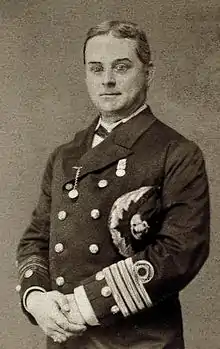Pelham Aldrich
Admiral Pelham Aldrich, CVO (8 December 1844 – 12 November 1930) was a Royal Navy officer and explorer,[1] who became Admiral Superintendent of Portsmouth Docks.
Pelham Aldrich | |
|---|---|
 Pelham Aldrich (1884) | |
| Born | 8 December 1844 Mildenhall, Suffolk |
| Died | 12 November 1930 (aged 85) Great Bealings, Suffolk |
| Place of burial | Great Bealings, Suffolk |
| Allegiance | |
| Service/ | |
| Years of service | 1859 - 1908 |
| Rank | Admiral |
| Commands held | HMS Sylvia HMS Fawn HMS Egeria |
| Awards | Royal Victorian Order |
Biography
He was born in Mildenhall, Suffolk, the son of Dr. Pelham Aldrich and Elizabeth Frances Aldrich, and married Edith Caroline Issacson in 1875.[2][3] He entered the Royal Navy as a Naval Cadet in June 1859[4] and was promoted to sub-lieutenant on 17 September 1864 and lieutenant on 11 September 1866. He served as a lieutenant on the corvette Scout, then from 18 December 1869 on the broadside ironclad Lord Warden and from 15 November 1872 on the Challenger.
Whilst on board the Challenger, he took part in the 4-year-long Challenger expedition of 1872–76 – a scientific expedition that made many discoveries to lay the foundation of oceanography. In 1875, he transferred to the sloop Alert to take part in the British Arctic Expedition, which was sent by the British Admiralty to attempt to reach the North Pole via Smith Sound. Aldrich commanded the Western Sledge Party to Ellesmere Island, and what is often described as the most northerly point of North America is named Cape Aldrich in his honour.[5][6] He became a commander on 3 November 1876 and commanded the Sylvia and Fawn on surveying expeditions of China and the Mediterranean. As captain of Fawn he, along with the scientist Stephen Joseph Perry, observed the 1882 transit of Venus from an improvised tent observatory in Madagascar.[7] He was promoted to captain on 29 June 1883, commanding the Sylvia and Egeria on further surveying expeditions of the Cape of Good Hope and Australia.
In 1888 Egeria visited Christmas Island. On board was Charles Wyville Thomson (who had been chief scientist on the Challenger Expedition) who named a crinoid Bathycrinus aldrichianus after Aldrich.[8] In 1978 a Christmas Island stamp was issued in his honour.[9]
Mount Aldrich, in Antarctica, was named after him by Robert Scott to thank him for his assistance given in preparing for Scott's expedition.[10]
Aldrich was promoted to rear-admiral on 21 December 1898, and served as admiral superintendent of Portsmouth Dockyard between 1 September 1899 and 1 September 1902, flagship HMS Asia.[11] He was appointed a Commander of the Royal Victorian Order (CVO) by King Edward VII in 1902.[12] The following year, he was promoted to vice-admiral on 12 August 1903 and finally admiral on 1 March 1907.
He retired from the Navy on 22 March 1908 and moved to The Croft, Great Bealings.[13] He died in Great Bealings and was buried in the local churchyard on 17 November 1930. His wife was buried in the same place on 6 May 1943, aged 94.[14]
References
- "Aldrich, Vice-Admiral Pelham". Who's Who. Vol. 59. 1907. p. 27.
- "Biography of Pelham Aldrich R.N." pdavis.nl. Retrieved 30 November 2010.
- 1851 UK Census Record
- "Royal Navy Flag Officers of the Dreadnought Era 1904-1945: Royal Navy Full Admirals". admirals.org.uk. Retrieved 30 November 2010.
- Hayes, Derek (2003). Historical atlas of the Arctic. books.google.co.uk. ISBN 9781553650041. Retrieved 30 November 2010.
- Alan Rayburn (January 2001). Naming Canada: stories about Canadian place names. books.google.co.uk. ISBN 9780802082930. Retrieved 30 November 2010.
- Transits of Venus, 1874 & 1882, Royal Astronomical Society
- "The Tumbrel Diaries: Christmas Island". angustrumble.blogspot.com. Retrieved 30 November 2010.
- Wikipedia List of Christmas Island stamps
- "Name Details - Australian Antarctic Data Centre". data.aad.gov.au. Retrieved 30 November 2010.
- "Naval & Military intelligence". The Times (36862). London. 2 September 1902. p. 4.
- "No. 27467". The London Gazette. 22 August 1902. p. 5461.
- 1911 UK Census
- Burial records from St Mary's, Great Bealings
| Military offices | ||
|---|---|---|
| Preceded by Vice-Admiral Ernest Rice |
Admiral-Superintendent of Portsmouth Dockyard 1899–1902 |
Succeeded by Rear-Admiral Reginald Friend Hannam Henderson |